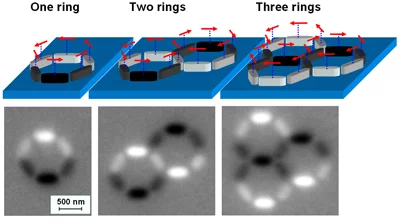Arrays of dipolar coupled ferromagnetic islands arranged in specific geometries provide ideal systems to
directly study frustration. We have examined with photoemission electron microscopy the magnetic configurations
in three basic building blocks of an artificial kagome spin ice consisting of one, two, and three rings.
The kagome spin ice arrangement is particularly interesting because it is highly frustrated and the three
interactions at a vertex are equivalent. Employing dipolar energy calculations, we are able to make a full
characterization of the magnetic states and therefore identify the lowest energy states. Experimentally we find
that the ice rule is always obeyed even at low dipolar coupling strengths. However, as the number of rings
increases there is a drastic decrease in the ability to achieve the low-energy states via demagnetization, a
behavior also identified in the magnetization reversal. This carries the implication that the ground state will
never be achieved in the infinite system. Finally, we show that at low coupling, the applied field direction
governs the resulting states. This work opens the door to a novel class of systems for future spintronic
applications.
Read full article
Read full article
Facility: SLS
Paul Scherrer Institut, 5232 Villigen PSI, Switzerland,
Email: elena.mengotti
Dr. Laura Heiderman, Research Group Leader
Paul Scherrer Institut, 5232 Villigen PSI, Switzerland
Email: laura.heyderman
Reference
Building blocks of an artificial kagome spin ice: Photoemission electron microscopy of arrays of ferromagnetic islands, by E. Mengotti et al., PhysRevB,78 144402 (2008).Contacts
E. MengottiPaul Scherrer Institut, 5232 Villigen PSI, Switzerland,
Email: elena.mengotti
Dr. Laura Heiderman, Research Group Leader
Paul Scherrer Institut, 5232 Villigen PSI, Switzerland
Email: laura.heyderman
